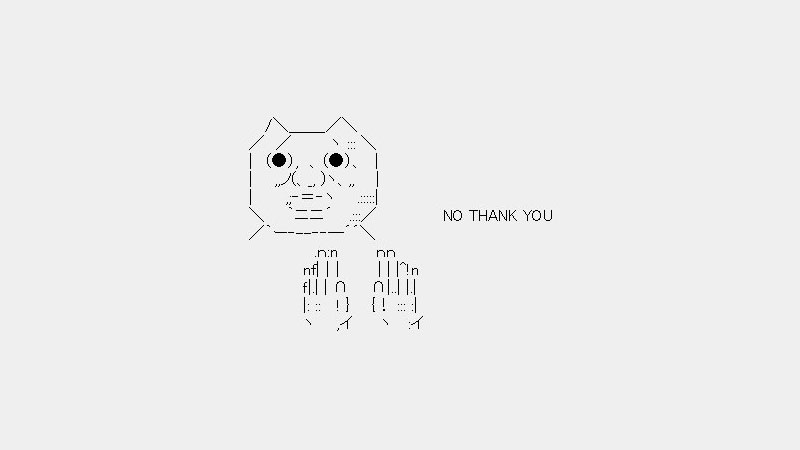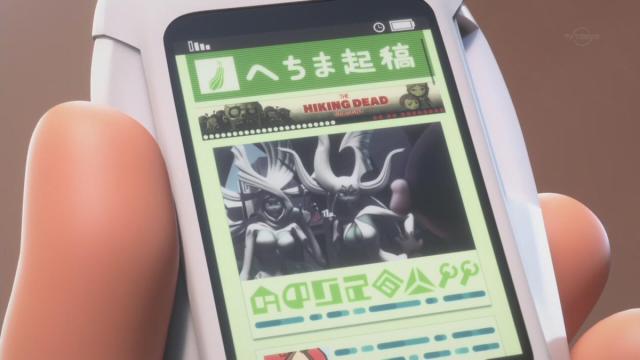It’s actually not too different from the way people outside the country get their gaming news, but there are a few local twists.
[Image via Hachima Kikou]
The above image is from Level-5’s newest anime The Snack World, which mixes contemporary Japanese mass culture with a role-playing game type world. In the image, the top banner reads “Hechima Kikou” (へちま起稿) and is a parody of Japanese game blog Hachima Kikou (はちま起稿). Even the spoof font is the same as the blog’s! I can’t help but think that if this were 10 years ago, it would have been a parody of Japanese game mag Weekly Famitsu.
So much has changed in the past decade or so in Japan and abroad with the rise of the internet and social media. But before that, Japan already had a vibrant net culture, thanks to 2ch. Way back in 1999, the online Japanese message board was founded by Hiroyuki Nishimura while he was a student at University of Central Arkansas. Today, it’s still a major force online. Wired compared it to NeoGAF, but you could also say it’s the Reddit of Japan. It has defined so much of the country’s net culture for years.
Game blogs made it big in the West slightly before they did in Japan, with the big ones coming online in around 2007, building their audience from there. The delay, I think, might be because 2ch was already entrenched and regular users were already getting much of their news — gaming and more — from the board.
Japanese sites such as Hachima Kikou and My Game News Flash were two of the first to hit it big, and today, they’re probably the most famous in Japan. They have traditionally been rivals, and the way they cover news, culture and the internet has influenced a plethora of upstarts that followed in their wake. It’s now hard to tell where stories originate, because it seems like there is an endless stream of similar type Japanese blogs getting up posts so quickly. But those two have been incredibly influential in how blogs are laid out and how they cover news. (Full disclosure: Jin, the guy who founded My Game News Flash, once wrote for Kotaku Japan, which was operated and published by another company. I’ve met Jin a few times. He seemed nice.)
Since the late 2000s, Japanese game blogs have established a style that’s different from their international counterparts. What I like and admire about Japanese game blogs is the fluidity they move between video game stuff and, basically, whatever they think is interesting. They’re rooted in gaming, but they cast a wide net that includes obvious related topics such as manga and anime as well as seemingly unrelated ones such as politics, current events and showbiz. Readers do troll the sites, but there seems to be fewer commenters asking why things were posted. Another thing these blogs do extremely well is to package stories with solid titles and then get out of the way of said story or topic. Writing is often minimal, so they don’t seem to get in a rut of hot takes. If something is cool or interesting, they don’t need to explain that. A wry quip or some Shift_JIS art might be enough.

[Image via My Game News Flash]
However, since most of what they do is aggregate, curating stories that also appear on 2ch or on Twitter, they don’t always have the robust reporting that the wordier sites do. There are geek sites such as Net Lab, which do a good job of writing in a playful and informative way about otaku news or culture, that do report out stories and follow up leads. (In the past few years, Twitter has become even more important for finding game news in Japan. Since you are able to fit more Japanese words and characters in a tweet, the platform has been embraced in Japan.)
While the rise of these blogs has been a big change over the past 10 years with how gaming news is consumed in Japan, it isn’t a complete one. Weekly Famitsu and the Dengeki imprints have strong online presences (here and here). Online, both tend to report press releases and PR events, which certainly have their place, and they don’t cover online or gaming culture like the Japanese blogs do. Instead, they read more like trade publications sometimes, explaining why people in Japan who really follow gaming closely read both types of sites. Or, at least, they’re paying attention to the Famitsu or Dengeki stories that appear on the blogs.

A special Famitsu issue on Ubisoft spotted on store shelves. [Photo: Kotaku]
According to data from the Japanese Magazine Publishers Association, Weekly Famitsu‘s circulation was 500,000 in 2009. Its publisher now lists the magazine’s circulation as 300,000. Those are still the biggest numbers for any game print pub in Japan, and no matter what you think of Famitsu, it’s long been part of gaming culture in Japan. It was first published bi-weekly in June 1986 as Famicom Tsushin (ファミコン通信) or “Family News”, capitalising on the mid-’80s craze for Nintendo’s Famicom (NES in the West). The name was shortened to Famitsu, and the title of the now weekly magazine is actually Shukan Famitsu (週刊ファミ通) or “Weekly Famitsu”. The magazine features nuts-and-bolts game previews, columns, reviews, sales data, interviews with game developers as well as ones with pop idols, and tame bikini or fashion model photos.
It isn’t only game magazines in Japan that have seen their circulation drop over the past decade, but also weekly manga. This isn’t unique to Japan. What’s interesting is that print game magazines in Japan not only continue to have exclusives, but those exclusives continue to end up online before the magazines go on sale. In the case of Famitsu, this happens on a weekly basis: Summaries of the magazine leak online on Tuesday before the magazine goes on sale on Thursday. Japanese game blogs often publish the summaries. Famitsu.com, however, publishes previews on what’s in the upcoming issues on Tuesday and has been doing so since at least 2010. I have no idea if Famitsu is doing this because of the Japanese internet leaks (Famitsu declined to be interviewed for this story).
Yet, there still appears to be something about getting the actual 250-page magazine with the full articles and well-designed layout. Anecdotally, I know that if I do not go and buy Famitsu at my local book store before kids get out of school, it will be sold out that afternoon. Circulation might have dropped in comparison to those 2009 numbers, but people still buy and read the print edition, even in 2017. And when they finish with that, there’s always the internet.

Comments